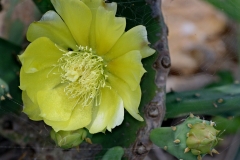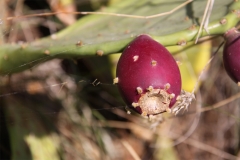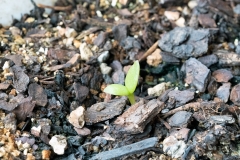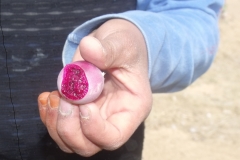Stems
Stems are hairless, dull green or bluish-green and consists of series of fleshy segments each 30 cm long, 15 cm wide and 1-2 cm thick. Each areole has short tufts, finely barbed bristles and one to two stout yellow spines which measures 2-4 cm long.
Leaves
Leaves are erect and scale like formed beneath the aeroles on young segments and are shed as segments matures.
Flowers
Flower petals are lemon yellow having greenish or pinkish markings on the back. Flowers are 6-8 cm diameter and are stalkless.
Fruit
Fruits have reddish-purple skin and reddish flesh. Fruit is 4-6 cm long and has tufts of fine barbed bristles in areoles.
- It is used as antidiabetic and anti-inflammatory in folk medicine.
- Stem segments are used to treat whooping coughs and diabetes.
- The plant is used in India for burning, biliousness, urinary complaints, leucoderma, loss of consciousness, tumors, inflammations, piles, ulcers, anemia and enlargement of spleen.
- Heated plant juice is used for tumors and leucoderma.
- It is used for gonorrhea.
- Apply the mashed leaves as poultice to alleviate heat and inflammation.
- Apply the leaf pulp to eyes in case of ophthalmia.
- Flowers are used for asthma and bronchitis.
- Roots are used to induce vomiting in case of poisonous snake bites.
References:
https://www.itis.gov/servlet/SingleRpt/SingleRpt?search_topic=TSN&search_value=19736#null
https://en.wikipedia.org/wiki/Opuntia_stricta
Comments
| Erect Prickly Pear Quick Facts | |
|---|---|
| Name: | Erect Prickly Pear |
| Scientific Name: | Opuntia stricta |
| Origin | Native to the Caribbean region, tropical and subtropical coast of eastern North America, and adjacent South America |
| Colors | Red to purplish red |
| Shapes | Ellipsoid or barrel-shaped, 4–6 cm long, 2.5–4 cm diameter |
| Flesh colors | Reddish |
| Name | Erect Prickly Pear |
|---|---|
| Scientific Name | Opuntia stricta |
| Native | Native to the Caribbean region, tropical and subtropical coast of eastern North America, and adjacent South America |
| Common/English Name | Araluen Pear, Coastal Prickly Pear, Australian Pest Pear, Coastal Prickly-Pear, Common Prickly Pear, Common Pest Pear, Dildo, Eltham Indian Fig, Erect Prickly Pear, Eltham Indian-Fig, Erect Prickly-Pear, Erect Pricklypear Cactus, Erect Pricklypear, Gayndah Pear, Pakan, Pest Prickly-Pear, Pest Pear Of Australia, Pest Pricklypear, Southern Spineless Cactus,Sour Prickly Pear, Spineless Prickly Pear, Sweet Prickly Pear, Spiny Pest Pear, Sweet Prickly-Pear |
| Name in Other Languages | Afrikaan: Suurturksvy; Chinese: Xiang-Ren-Zhang, Hsian-Jen-Chang, Xian-Tao, Hsian-T’ao; German: Feigenkaktus; India: Nagphana (Bengal), Nagajemudu, Nagadali (Andhra Pradesh), Nagphan, Chhittarthor (Himachal Pradesh),Chorhathalo (Gujrat), Hathhathoria, Naghhana (Hindi), Palakakkali, Nagamullu (Kerala), Papaskalli, Chappatigalli (Karnatka), Chittarthohar (Punjab), Chapal (Maharashtra), Nagophenia (Orissa), Nagathali, Sappathikalli (Tamilnadu), Mahavriksha, Vajrakantaka (Sanskrit); Mexico: Yaaxpakan (Spanish); Portuguese: Palma-De-Espinho, Opúntia, Palmatória; Spanish: Chumbera, Nopal Estricto, Chumbera apretada, Pera Espinosa, Tun; French: Oponce ; English: Erect prickly |
| Plant Growth Habit | Spreading to erect, succulent shrub |
| Plant Size | 1–2 m high |
| Root | Shallow fibrous |
| Stem | 30 cm long by 15 cm wide by 1–2 cm thick |
| Flowering Season | Spring and summer |
| Flower | Hermaphrodite, 6–8 cm across, yellow to yellowish orange |
| Fruit shape & size | Ellipsoid or barrel-shaped, 4–6 cm long, 2.5–4 cm diameter |
| Fruit color | Red to purplish red |
| Flesh color | Reddish |
| Seed | Rounded, 4–5 mm diameter, pale brown |








